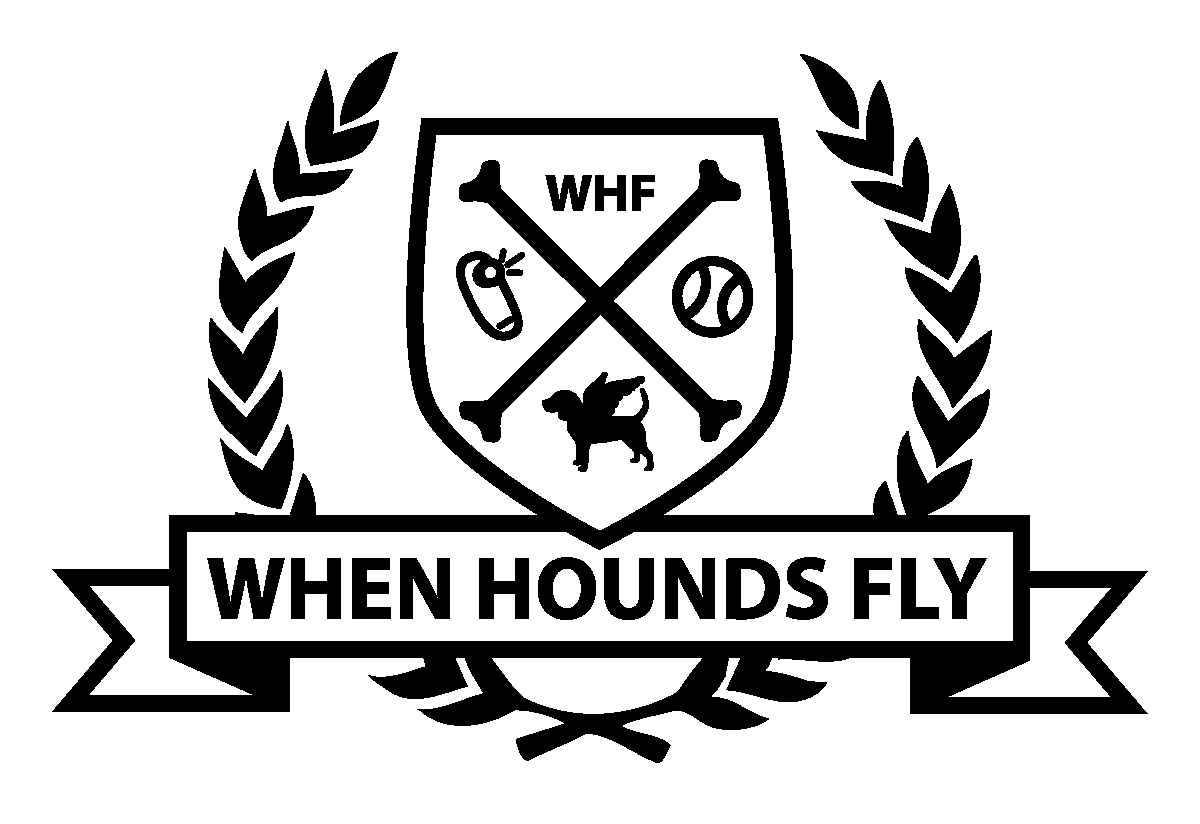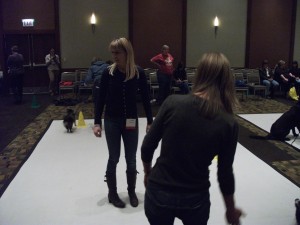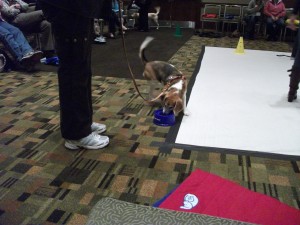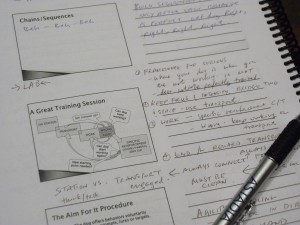Here we go! Day 3…
Session 1: Efficient Training in Action (Cecilie Køste)
This lab really focused on smart reinforcement placement. BUT, another key aspect of good training is everything that happens before you start training.
Her mantra is THINK – PLAN – DO. Thinking is “What is the behavior to be trained?” Plan is “What is the training plan, what is my criteria, where will reinforcement be delivered, what could go wrong, and what will I do?” When you are training… no thinking, no planning. That must occur before training begins. If the training session is falling apart, you must stop, put your dog at station, and go back to thinking and planning.
The exercises in this lab were:
Cup Game (Clicker Mechanics)
She had all the students warm up with a basic clicker trainer exercise – the cup game. How many treats can you put into a styrofoam cup while maintaining perfect form (feeding hand is still till click, no extra movements of the body, no speaking). I haven’t done this myself since my first KPA workshop over a year and a half ago.
Go to Target
This is the simple “Go to Cone” game we even do at Puppy Class at When Hounds Fly. The best way to use reinforcement here is to click, deliver the treat to the dog’s mouth, let them nibble it while you lure their body/head back towards the cone. When the dog has finished eating and is released, the cone is now right in their face for another repetition. Brilliant!
Finish Position
All the dogs here had finish positions already trained, ranging from kind of wide and sloppy requiring a big hand cue, to verbal only finish cues, to really snazzy jump, rotate mid air, and land in finish Obedience finishes. Efficient training means when you click and treat, let the dog nibble on the treat while the handler moves around and faces the dog in Front position, tucked really, really close (like Front). When the dog is finished nibbling, the dog is now ready to offer Finish again. Round and around you go…
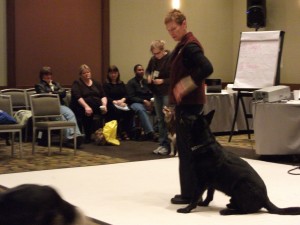
This dog had a great "flying" finish. The handler is about to treat and will allow the dog to nibble while she moves to Front position, setting up for another rep.
One tip that was mentioned about any of these obedience behaviors is the dog should get it right and perfect on the first repetition – otherwise you have a dog that learns to do a sloppy finish, then wiggle their butt in to get closer, c/t. Oops… Petey has that. Michele Pouliot calls this a “two part finish”.
Long Down – Feed in position (room service) – bring the treat to the dog to reinforce position.
Sit – Feed above head for a more tucked sit.
Stand – Feed towards chest
Reverse Lure – While a dog is in position, tease the dog with food in your hand, almost like you are trying to lure them into another position. If the dog maintains position, c/t.
“Many Downs” – How many downs can you get in a minute? C/T and toss the food to reset quickly, or after a down, handler moves away to get the dog up, so you can cue another down.
Rollover – Feed over the shoulder to encourage more rolling.
Hold Cloth – Shaping a hold of a hotel towel.
A common theme throughout the sessions I have taken – everything you do in training should be a conscious decision, and certainly I have learned to be very conscious about where I reinforce and why.
Session 2: Crosstrain! (Michele Pouliot)
This seminar should just have been renamed “Platform Training”. Platform training is relatively new. Michele had a DVD for sale at ClickerExpo that was flying off the shelves and kept on teasing me since it was played on a monitor in the hallway.
Platforms are so new in training that there are next to no videos on it on YouTube. I just found a handful… this one is the use of platforms to teach position/distance for Obedience:
The use of props in training is not new. We’ve used walls/edges to limit a dog’s option when trying to train a straight heel or a straight finish. We’ve used mats for position. Many are now teaching heel/finish using perches (or paint cans in my case for Petey). Platforms make it easy for dogs to delineate space. It makes it easy for us to understand criteria, since if the dog is on the platform, and it’s the right size, by definition, the dog is straight, and in the right position. Michele showed clips from her new video that shows platforms being used to train front, finish, weaves, go outs, tight spins, stay, and response from a distance work (like paw from a distance, while perched on a platform).
I intend to teach the 18 basic behaviors from Cecilie’s Top OTCh lecture on Day 1 to Petey again, but this time using platforms. I’m going to build my own platforms using leftover flooring from When Hounds Fly.
Lastly, she talked about other useful tools for training such as chutes, ledges, walls, x-pens, etc. to train behaviors. I was delighted to see all this, because Julie is doing the same stuff with our students in our tricks class right now. I love it whenever the methods we use at When Hounds Fly are validated by the world’s top clicker trainers. 🙂
Also, check out her “Step Up to Platform Training” DVD here. She starts training her litter of puppies at 4.5 weeks old. Wow!
http://cdf-freestyle.com/store.htm
Session 3: Learning Games and Play
Kay Laurence is “one of the world’s top clicker trainers” according to Karen Pryor. All weekend long, people were raving about her lectures so I decided to catch her on the very last track and session for the conference. I am glad I did! This topic was appropriately “light” in technicality but brilliant in terms of expanding my horizons of training. Specifically, Kay has very ingenious ways to incorporate playing with your dog as training.
Through play, we can teach dogs self control, body awareness, and movements such as backing up, side stepping, etc., all of which are needed for many different dog sports.
One important thing to think about (which I often don’t) is the safety of the game. She is adamant that dogs should never run around on laminate flooring, as it’s an easy way for them to pull a muscle, or worse. I guess it’s true -try running around laminate flooring in your socks and see how long it takes to pull a muscle. Her training facility is CARPETED and ripped up and replaced regularly.
She has a pretty large library of videos on YouTube so I’ll just share these videos for you to watch and enjoy. Have fun playing with your dogs!!!
Games with a Sausage (Catch the Mouse)
Egg Agility
Lastly, I thought I would share a few things from the Saturday (Day 2) evening dinner featuring Patricia McConnell. She lectured on the topic of animal cognition and how much animals think. I didn’t really take notes but she shared various research on different examples of studies done and also cited Ken Ramirez’s (Shedd Aquarium) work on teaching dogs to understand concepts like Big vs. Small, Mimicry, and of course dogs like Rico and Chaser (object recognition with both noun and verb). She showed some footage that I’ve found on YouTube for you to check out. They’re interesting and fun.
She also shared a few other recent studies about dogs understanding our pointing gestures better than chimpanzees, and also a study that showed domestication does not necessarily mean a dog’s problem solving ability is reduced (which is commonly believed to be true). Anyways I’m not really a scientist so I’ll just ask Krista (from UWO) next time I see her.
Julie, Mirkka, Emily and I had to leave at 4 to catch our flight home, so we missed the closing remarks by Karen and Patricia. Evidentally it was so moving there were 400 dog trainers in tears at the end. Oh well, next year I’ll plan to stick around! In the meantime, I have hundreds of slides and notes to review. Hope you enjoyed the blog series!
